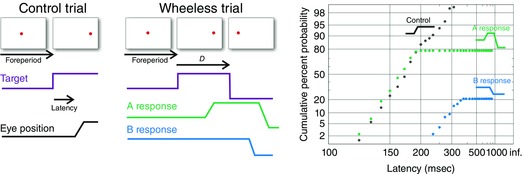Figure 2. The Wheeless task .

Left: in a control trial, after a random foreperiod, the target steps to one side and the subject makes a saccade to follow it after a delay: the latency or reaction time.In the Wheeless task, such trials are randomly interleaved with trials (middle) in which, after a delay D, the target steps to the opposite side. The subject may then respond by making two saccades: one to the first position (an A response, grey) followed by one to the second (a C response), or may jump straight to the second (a B response, black). Right, reciprobit plots of reaction times from one subject in this experiment, showing cumulative frequency as a function of reciprocal latency. The distribution for A responses (grey) is initially similar to that for controls (open circles) but then stops at a level dependingupon D (whose value here was 100 ms). The B responses (black) are greatly delayed but rise in a similar manner to a steady level.
